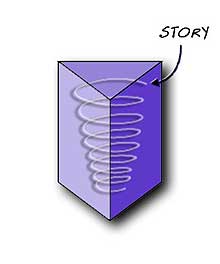
The answer to this is a long story but………..
When we say “I have a body” or “I have a mind” it gives the impression we are made up of separate things called body and mind. It is really a way of talking, and in some ways it trips us up.
It is probably more accurate to say I AM PHYSICAL and I AM SUBJECTIVE and I AM SPIRITUAL and I AM RELATIONAL and so on.
I am all these things.
They are all dimensions of me, one ‘whole’ person.

These dimensions are not far apart, like two houses in a street, or even like separate rooms in a house. They are intimately part of one another.
In many ways I (Brian Broom) prefer now to see a person as an I AM rather than as a set of boxes one has to try to connect together, which is in fact the dominant Western way of looking at persons.

Now when something important happens in life to disturb us (like the arrival of a new brother, the death of a parent, or the loss of friends, or sexual abuse, or shifting home, or any number of things) the disturbance within us can be expressed in several dimensions.
For instance, in action (I can hit somebody, or start performing badly), in language (I can start yelling, or talk too much, or stop talking), in feelings (I can feel angry, or grief-stricken, or anxious), or in bodily symptoms (I can develop headache, bowel disturbance) or in disease (like the frustrated woman with bowel and skin disease who developed worsening symptoms every September).
 The Prism
The PrismThis shape suggest the idea that the person is a WHOLE being, but that there are many aspects to him. And what a doctor actually sees of the person depends on what place the doctor is coming from.
Let’s explain this. It’s quite easy. First see the prism as empty.
 The Story
The StoryThe next diagram shows that each person (prism) has his own special story. That story can be expressed in several ways.
 Story Expressed in Language
Story Expressed in LanguageIt can be expressed in LANGUAGE.
Let’s say a person has been abused or hurt in some way and certain situations make him angry, then he may express that anger in verbal language, words, in statements as simple as “I am angry”—or in more complicated ways.
 Story Expressed in Action
Story Expressed in ActionIt can be expressed in ACTION.
The angry man may work too hard, or go running, or drink too much.
He may not even know he is angry, but digging deep we find that these action patterns are at least partly maintained by his story with its anger.
 Story Expressed in the Body
Story Expressed in the BodyIt can be expressed in the BODY in the form of symptoms and disease.
This is very common, and it’s what this software is about.
We all express some of our story in the body at some time or some stage of our lives.
 Making the Connection
Making the ConnectionWe go to the doctor, but it is often as if the connection of our symptoms to the rest of us is covered up.
But our symptoms and disorders come out of the whole of us, and by dealing with the connections between our symptoms/illnesses/diseases and our stories we can make a contribution to healing.
If this is so what can be done?
Firstly, and most simply, just knowing about the specific connections can be healing.
Some people need to start putting the ‘energies’ causing bodily symptoms into another form (like talking about it) to get better.
Others need to start to recognize feelings better so they do not automatically develop symptoms in the body.
 Recognition and Resolution
Recognition and ResolutionThere is a lot more that can be said about the processes of healing via knowing story but in the end it is a matter of what is the best way to recognize and resolve those meaningful and disturbing things which occur in the life of every human being.
Expressing them in a disease form is not a good outcome.
IF YOU WANT MORE ON HOW KNOWING YOUR STORY HEALS, SEE BRIAN BROOM’S BOOKS and other publications:
These books were originally written for doctors and psychotherapists but have proved highly accessible to patients concerned to get their heads around the concepts. They contain detailed case histories giving good examples of how patients make a healing journey by tackling the relationship between their personal ‘stories’ and their illnesses.